Latest Bedroom Color Ideas for Elegant Spaces
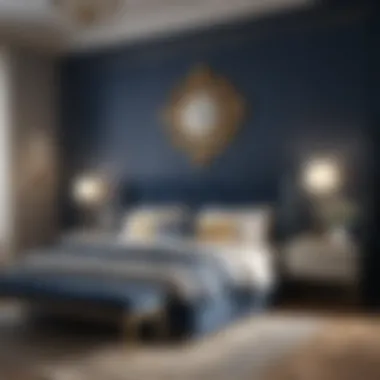
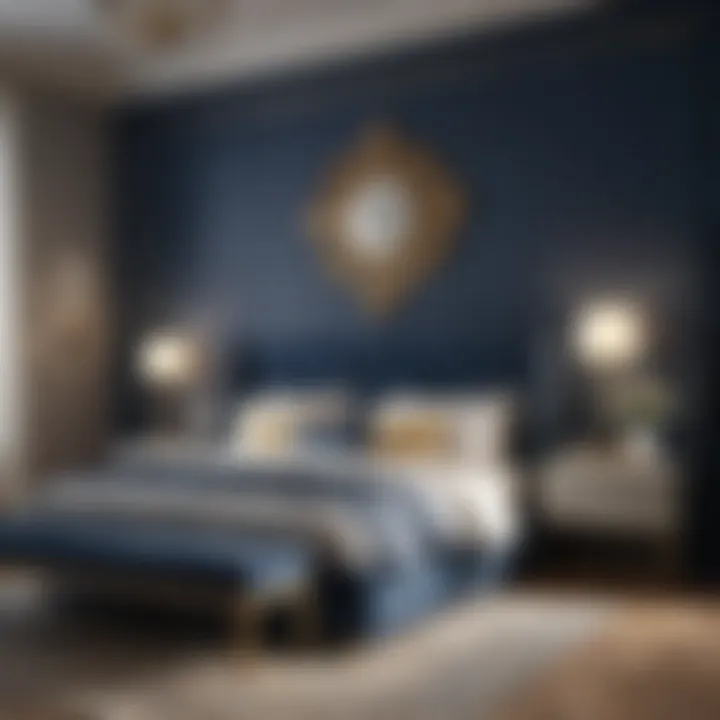
Intro
Introducing the concept of color in bedroom design is essential for creating an inviting and elegant living space. Color not only shapes the atmosphere but also influences our emotions and productivity. With the latest trends in mind, homeowners and interior design enthusiasts may seek ways to elevate their bedrooms. This article will delve into contemporary color palettes, their psychological impact, and practical applications. Furthermore, it will explore how to harmonize these colors with various design styles to create a cohesive look.
Design Inspiration
Current Interior Design Trends
Today’s interior design trends reflect a move towards embracing personalized aesthetics while maintaining sophistication. Popular colors such as rich navy blue, soft sage green, and warm terracotta are dominating recent designs. Each hue brings a unique character. For instance, navy blue adds depth and serenity, while sage green promotes tranquility and connection to nature.
To achieve a modern feel, consider combining these colors with lighter, neutral tones. Shades like soft beige or crisp white can act as balancing elements, allowing the bolder tones to stand out without overwhelming the space.
Key Trends:
- Bold Accents: Utilize vibrant colors in small doses, such as throw pillows or blankets.
- Muted Shades: Create a calming atmosphere with softer tones that still feel luxurious.
- Monochromatic Schemes: Stick to varying shades of one color for a unified and elegant look.
Color Palettes and Their Effects
Exploring color palettes is crucial. Each color has psychological connotations, which can affect how a space feels and functions. For example:
- Blue: Calming and serene, this color is often associated with stability and trust.
- Green: Symbolizing nature, green promotes relaxation and rejuvenation.
- Yellow: This color can energize a room, but it's best used sparingly, as it may become overwhelming.
Using color effectively means understanding its mingling effects. Pairing a refreshing green with a calming blue encourages balance, while a splash of yellow can inject energy without dominating the scheme.
"Color does not add a pleasant quality to design – it reinforces it."
— Pierre Bonnard
In summary, a well-thought-out color palette enhances the elegance of a bedroom while supporting its intended mood. Homeowners should experiment with combinations that resonate with their personal styles and preferences.
The End
Understanding color schemes is vital for creating a sophisticated bedroom. By staying informed about current trends and recognizing the psychological effects of various colors, homeowners can make educated choices that transform their living spaces. The right color can create an atmosphere of calm, infuse energy, or provide a sense of warmth and security. Therefore, it is essential to embrace the latest color ideas thoughtfully.
Preamble to Bedroom Color Trends
The choice of color in a bedroom goes beyond mere aesthetics; it profoundly influences the ambiance and emotional quality of the space. Every hue carries a sense of meaning and can transform an area from a mundane retreat to a sanctuary of comfort and elegance. Understanding current color trends is essential for homeowners and design enthusiasts aiming to create harmonious spaces.
Color trends reflect societal shifts, personal preferences, and stylistic directions in the world of interior design. As people seek to express their individuality, bedroom colors evolve. It is vital to explore these trends to grasp how they can enhance not just the look but also the feel of one's living environment.
When considering bedroom color palettes, one should keep in mind several crucial elements:
- Emotional Impact: Different colors evoke distinct feelings. For instance, tranquil blues or greens can promote relaxation while vibrant reds can energize the space. Understanding these emotional triggers assists in selecting the right hue for personal well-being.
- Cohesion with Design Styles: Colors must complement the overall design style of the bedroom. For example, modern minimalist designs often favor neutral palettes, whereas Bohemian styles might benefit from rich jewel tones.
- Practicality of Maintenance: Darker colors may require more frequent cleaning to maintain their appeal, while lighter shades can alter the perception of space size.
In summary, integrating the latest color ideas into bedroom design not only refreshes the look but also enhances the psychological experience of the space. Keeping abreast with bedroom color trends empowers individuals to curate an environment that resonates with their style and emotional needs.
Understanding Color Psychology
Color psychology plays a crucial role in interior design, especially in bedrooms where ambiance and relaxation are paramount. Understanding how colors affect emotions and perceptions can significantly enhance the overall aesthetic of a space. Beyond mere decoration, color choices can instigate feelings of calmness, energy, or even nostalgia. As such, conscientious selection of hues can improve the quality of rest and elevate moods, making the choice of colors not only a stylistic preference but also a psychological strategy.
When designing a bedroom, one must consider how the chosen color palette aligns with personal feelings and needs. Different colors evoke distinct responses. For instance, blues and greens are often associated with tranquility, while yellows and reds can evoke more vivacious feelings. This knowledge allows homeowners to craft spaces tailored to their emotional requirements.
Additionally, integrating colors knowingly can lead to benefits such as enhanced focus or reduced anxiety. Curating a harmonious environment through color can also align with the natural lighting of the room, further influencing how these shades are perceived throughout the day.
How Colors Influence Mood
Colors have a profound impact on human emotions. For instance, soft pastels create a gentle and soothing atmosphere, which is conducive to relaxation and sleep. Shades like lavender and soft pink have been shown to calm the mind, making them popular choices for bedrooms.
In contrast, darker tones might be employed to create a cozy or intimate feeling but can sometimes lead to a heavy or oppressive mood if overused. Below are some common associations:
- Blue: Soothing, promotes tranquility
- Green: Refreshing, symbolizes nature
- Yellow: Cheerful, stimulates energy
- Red: Passionate but can be overwhelming
- Grey: Neutral but can feel uninviting if too cold
Thus, when selecting colors, it is essential to evaluate personal responses. Testing colors on small patches of walls before committing to a full application is a practical method to ascertain their emotional effect in a live context. This approach capitalizes on the unique ways in which light interacts with pigments at different times of the day.
Choosing Colors Based on Personality
Understanding your personality is crucial when selecting colors for your bedroom. Individual preferences can dramatically affect how colors are perceived and their emotional impact. For instance, a creative individual may be drawn to vibrant colors that energize and inspire, while someone who values serenity may prefer muted tones that promote relaxation.
Here are several personality considerations for color choice:
- Creative individuals may gravitate towards bold, unexpected combinations that express uniqueness.
- Analytical thinkers may prefer sharper, more defined colors that suggest structure and organization.
- Easy-going personalities might choose softer, comforting colors that reflect tranquility.
- Adventurous spirits may opt for eclectic palettes that mix styles and shades, enabling an atmosphere of exploration.
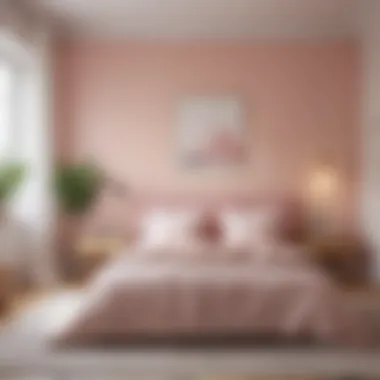
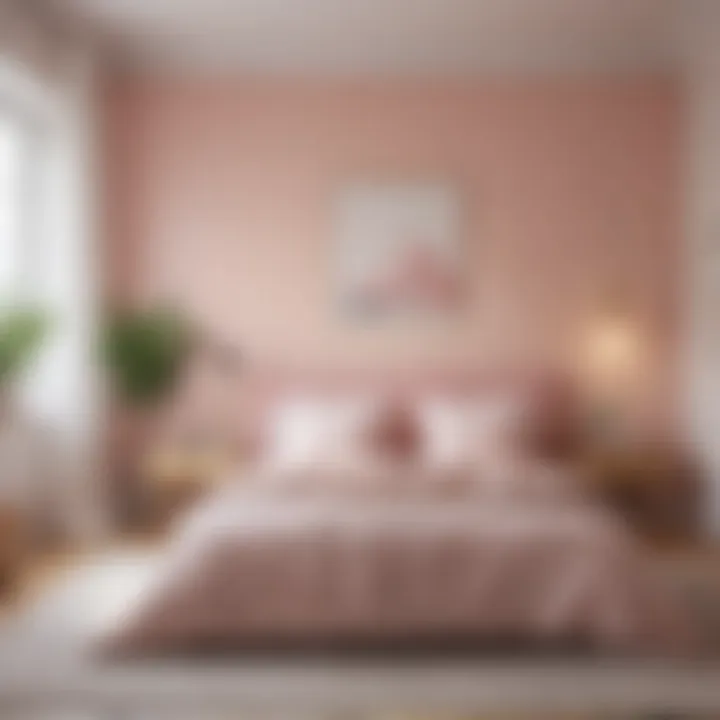
To summarize, understanding one's self helps in crafting a bedroom that resonates positively. Thoughtful color choices based on personality traits can enhance overall happiness and comfort in the space. It opens up possibilities not just for decoration but for personal expression that feels authentic.
Color is the keyboard, the eyes are the harmonies, the soul is the piano with many strings.
By weaving together the psychological effects of colors and personal preferences, one can create a sanctuary that truly embodies elegance and comfort.
Current Color Palettes
Current color palettes are essential to consider when designing a bedroom space. They are more than just aesthetic choices; they have the power to transform the atmosphere, allowing one to craft a soothing retreat or an energizing escape. By selecting the right color palette, homeowners can create environments that resonate deeply with personal styles and preferences. It is crucial to look beyond mere visual appeal—colors can profoundly affect mood, perception, and overall well-being.
Earthy Tones for a Calm Retreat
Earthy tones often evoke a sense of tranquility and grounding. Shades like terracotta, muted greens, and warm browns create a natural vibe that connects the indoors with the outdoor world. This connection can be particularly beneficial in a bedroom, a space meant for relaxation and rejuvenation. Using earthy tones allows for the incorporation of natural materials and textures, which enhance the calming effect. Moreover, these colors can anchor space, creating a cohesive look when paired with wood furniture or natural fabrics. One can easily achieve an organic feel by combining different earthy shades, allowing depth without overwhelming the senses.
Bold Accent Colors
In contrast to the muted earthen palette, bold accent colors can add vibrancy and personality. Shades like deep blue, emerald green, or vivid red can serve as focal points in a bedroom. These colors command attention and can become conversation starters. When used sparingly, such as on a feature wall or through accessories, bold colors can energize the space without overpowering it. They work well to offset neutral base colors, thereby bringing life to the room. Homeowners must consider balance, ensuring that these bold accents are harmonized with softer tones to maintain an inviting atmosphere.
Soft Neutrals for Timeless Appeal
Soft neutral colors, such as beige, soft gray, or pale white, always remain in style. They provide a blank canvas that allows the homeowner to easily incorporate other design elements, patterns, and textures without clashing. These colors are particularly effective in small spaces, as they make rooms appear larger and more open. By layering different neutral shades, one can create a sophisticated, elegant look. Soft neutrals also have the versatility to evolve with changing decor trends, adapting to new furniture or accessories. This adaptability makes them a practical choice for anyone looking to achieve longevity in their design.
In essence, selecting the right color palette is not merely a design task. It requires thoughtful consideration of how colors influence our emotions and interactions within a space.
In summary, understanding current color palettes is a vital part of creating elegant living spaces. Whether opting for calming earthy tones, invigorating bold accents, or timeless soft neutrals, each choice impacts the overall aesthetic and experience of the bedroom. This awareness can lead to a truly personalized haven.
Incorporating Trends into Existing Spaces
Integrating current bedroom color trends into existing spaces offers multiple benefits. Many homeowners desire an aesthetic that reflects contemporary styles while maintaining personal touches. It's not only about color; it's about the atmosphere and feeling those colors evoke. When you incorporate these trends, you create a living environment that feels fresh and inviting.
A significant part of this process is assessing what currently exists in your space. Consider furniture, existing color schemes, and architectural features. Adapting trends doesn't mean a total overhaul; often, subtle changes can dramatically impact the overall feel.
The importance of incorporating trends lies in their ability to revitalize a space without extensive renovation. Making small adjustments can lead to higher satisfaction with your bedroom. This approach can also enhance the resale value of a home, as potential buyers often favor modern, updated aesthetics. Here, we focus on two effective methods: painting techniques and the use of wallpaper.
Painting Techniques for Depth
Choosing the right painting techniques can add depth to your bedroom. Techniques such as ombre, sponging, and color washing provide texture that standard flat paint cannot achieve. These methods create interest on walls and help in breaking up large areas of color.
This section explores a few techniques:
- Ombre: Gradually blends one color into another. This adds a dreamy effect and often makes spaces feel larger.
- Color Washing: Combines a light shade of paint with a glaze for a soft, textured appearance. It’s subtle but effective in creating a layered look.
- Stripes: Horizontal or vertical stripes can make walls feel taller or wider. Stripes can also incorporate two different colors, adding more visual interest.
These methods can significantly alter the feel of a room, allowing homeowners to express their style in innovative ways.
Using Wallpaper to Enhance Color
Wallpaper is making a comeback, proving to be a powerful tool in bedroom design. It provides an opportunity to experiment with colors and patterns without permanence. Wallpaper can entirely change the mood of a room and serve as a focal point.
Consider the following points when using wallpaper:
- Pattern Choice: Select patterns that resonate with your personality. Botanical prints can create a refreshing atmosphere, while geometric designs offer modern appeal.
- Accent Walls: Instead of wallpapering an entire room, consider an accent wall. This draws attention to one area and allows you to use bolder patterns without overwhelming the space.
- Temporary Options: Removable wallpaper is ideal for those who wish to frequently refresh their space. This flexibility provides room to explore various aesthetics as trends evolve.
In summary, trends can be incorporated seamlessly into existing spaces through thoughtful application of paint and wallpaper. These strategies not only enhance aesthetic but also improve personal satisfaction with living environments. By embracing current trends, homeowners can enjoy a stylish oasis that reflects contemporary design principles.
Color Combinations to Consider
Understanding color combinations is essential for homeowners and design enthusiasts. The right combination can transform a space, adding depth and harmony. Color choices impact not just aesthetics, but also how individuals feel in a room. A well-thought-out color scheme can create a specific vibe and reflect personal style. It's important to consider how colors work together, their psychological effects, and how they can enhance or diminish the perceived size of a space.
Complementary Colors
Complementary colors are opposite each other on the color wheel. This means that pairing them creates a vibrant contrast. For instance, combining a rich navy blue with a bright orange can energize a bedroom, adding life and interest to the design. Using complementary colors can highlight architectural features and draw attention to specific areas in a room.
When selecting complementary hues, consider the proportions carefully. One color may dominate while the other acts as an accent. This balance is key to maintaining harmony in the design.
Here are some ideas for complementary color pairings:
- Navy blue and orange
- Sage green and blush pink
- Deep purple and sunny yellow
Do not overpower the space. These colors can create a cozy yet striking environment when used thoughtfully.
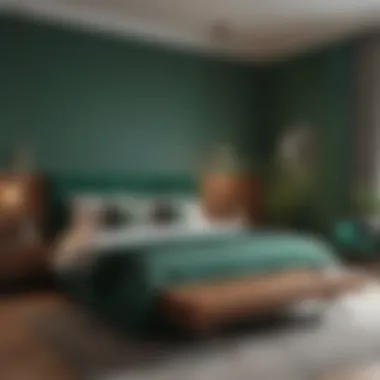
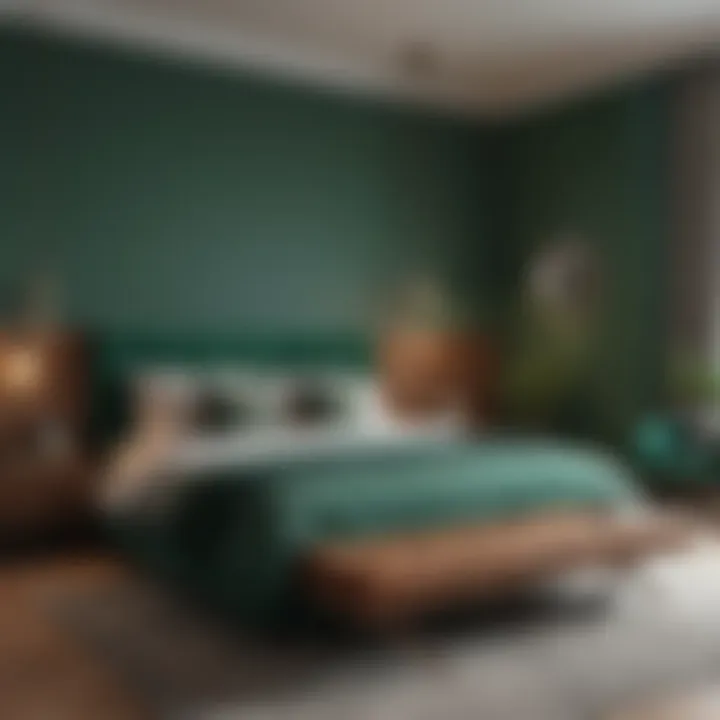
Monochromatic Schemes
Monochromatic schemes involve using variations of a single color. This approach creates a serene atmosphere, promoting a feeling of unity. For example, light beige paired with deeper taupe can give a sophisticated and modern look. This method emphasizes subtle variations in tone and texture, drawing the eye across the space without the distraction of competing colors.
Choosing a monochromatic color scheme allows for versatility in other elements such as furniture, decor, and textiles. Consider using different materials to add texture. A smooth linen throw, paired with a chunky knit pillow, can make the color variations pop.
Benefits of monochromatic color schemes include:
- Simplicity: Reduces the number of colors to think about.
- Consistency: Creates a cohesive look.
- Adaptability: Works with many styles.
The Role of Lighting in Color Perception
Understanding the role of lighting in color perception is crucial for achieving an elegant and harmonious bedroom atmosphere. The impact of light can dramatically alter how colors appear and feel within a space. This means that the selection of lighting needs careful consideration to truly enhance the aesthetic appeal of bedroom color schemes.
The right lighting helps to highlight the nuances in color, revealing subtleties that may sometimes be lost in shadow or harsh brightness. Moreover, it can influence the overall mood of a room. Effective lighting schemes can create depth, highlight textures, and establish a sense of warmth or coolness, making the space feel inviting or tranquil. Let's delve into the specific elements concerning natural and artificial lighting that homeowners should consider.
Natural Light Effects
Natural light has a unique quality that can infuse a room with vibrancy. It varies throughout the day, shifting with the sun's position. For instance, morning light tends to have a cooler tone, while afternoon light is warmer and more golden. Here are several points to recognize when utilizing natural light in your bedroom:
- Time of Day: Color perceptions can change dramatically with the time of day. Warm colors might appear softer in the morning, while they may gain intensity in the afternoon sun.
- Window Orientation: The direction your windows face determines how much natural light enters. South-facing windows receive the most light throughout the day, highlighting hues like yellow and cream, whereas north-facing windows provide softer, diffused light that might enhance cooler colors such as blues and greens.
- Sheer Fabrics: If you use sheer curtains, they can help to diffuse harsh sunlight, allowing colors to blend harmoniously while still letting in a pleasant amount of illumination.
Observing how colors respond as natural light changes during the day can inform smarter color choices for your bedroom.
Artificial Lighting Considerations
While natural light can enhance color perception, artificial lighting plays a key role, especially in the evening hours. It is important to consider the type of light bulbs used, their color temperature, and placement. Here are some essential factors:
- Color Temperature: Light bulbs come in various color temperatures, measured in Kelvin. Warmer lights (around 2700K to 3000K) create a cozy atmosphere, suitable for bedrooms. On the other hand, cooler lights (above 4000K) can feel sterile. Choosing wisely can greatly impact how colors are perceived in the room.
- Layering Lighting: A well-lit space should incorporate multiple light sources. Consider a combination of ambient lighting, task lighting, and accent lighting. Each layer serves its purpose and contributes to an overall balanced visual experience.
- Dimmers and Smart Technology: Installing dimmers allows you to customize the intensity of light depending on your mood or time of day. Smart technology can even adjust colors to match varying daylight, promoting a harmonious balance.
"Lighting is not just functional; it is vital for creating the right atmosphere and enhancing your color choices."
By acknowledging the interplay of natural and artificial lighting, you can achieve a bedroom that not only showcases your color palette beautifully but also resonates with the desired ambiance. Understanding color perception’s nuances through lighting will enhance your space, creating a genuinely elegant living environment.
Color and Design Styles
In the realm of interior design, color selection significantly influences the overall aesthetic and functionality of a space. Understanding the relationship between color and design styles is crucial for creating a harmonious bedroom environment. Each style has its unique palette that not only defines its character but also enhances the emotional resonance it evokes. By incorporating the right colors, homeowners can align their bedrooms with their personal taste while appealing to current trends.
Modern Minimalism
Modern minimalism emphasizes simplicity and functionality. The color palette often features a neutral base such as whites, grays, and beiges. These tones create an open feel, promoting relaxation and clarity. Adding splashes of muted colors, such as dusty blues or pale greens, can soften the starkness, providing a calming atmosphere.
To achieve modern minimalism:
- Focus on clean lines and fewer furnishings.
- Use varying shades of a single color to create depth without cluttering.
- Consider matte finishes for a contemporary touch.
This approach not only promotes an elegant living space but also supports a clutter-free mind.
Classic Elegance
Classic elegance draws on rich color schemes and timeless aesthetics. Deep jewel tones like navy, emerald, and burgundy are often utilized, paired with neutral colors for balance. These choices reflect a sense of grandeur and sophistication, perfect for those who appreciate tradition in their decor.
Key elements in achieving classic elegance include:
- Incorporating ornate furniture pieces.
- Utilizing luxurious fabrics, such as silk or velvet.
- Choosing art and decor that showcase craftsmanship.
The blend of rich colors and traditional aesthetics cultivates an inviting yet refined environment.
Bohemian Flair
Bohemian flair is characterized by playful color combinations and an eclectic mix of design elements. This style promotes a sense of free-spiritedness, utilizing vibrant hues like burnt orange, deep red, and golden yellow. Layering different textures and patterns enhances the aesthetic, making the space feel layered and lived-in.
To embody the Bohemian vibe:
- Mix and match vivid patterns and textures without fear.
- Include plants and natural elements to soften the look.
- Use throw pillows and textile art to introduce new colors effortlessly.
The result is a vibrant, inviting space that echoes personal stories through color and design.
Sustainable Color Choices
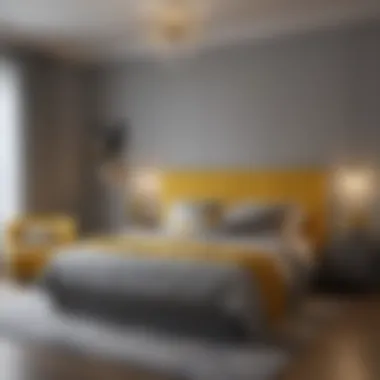
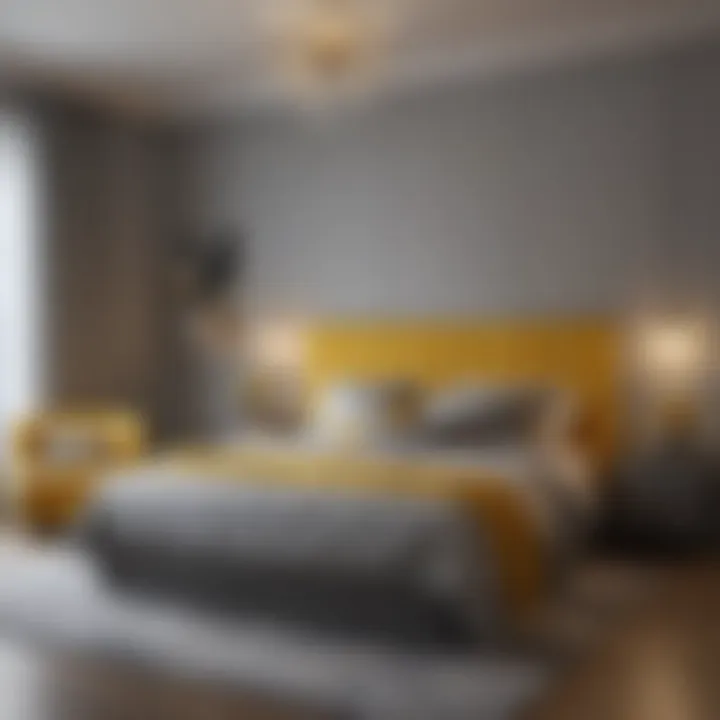
Sustainable color choices have become a significant focus for homeowners and designers alike. As people become increasingly aware of environmental issues, the demand for eco-friendly options in home decor, particularly in the bedroom, is on the rise. Sustainable products are not just a trend; they represent a commitment to health, well-being, and a cleaner planet. Using sustainable colors can contribute to creating a stylish yet conscientious living space.
One of the primary benefits of sustainable color choices is the reduction of harmful substances in your home. Many traditional paints and wallpapers contain volatile organic compounds (VOCs) that can harm both health and the environment. By opting for eco-friendly alternatives, homeowners can reduce indoor air pollution and support a healthier living environment. Furthermore, sustainable options often utilize natural pigments and materials, which are safer and more sustainable.
Some considerations for sustainable color choices include:
- Source: Look for paints and wallpapers that disclose their production practices and sourcing of materials. Products that are certified organic or made from recycled materials tend to be more environmentally friendly.
- Durability: Selecting products that are long-lasting can decrease the need for frequent replacements, thereby reducing waste over time.
- Local Manufacturing: Supporting local manufacturers can reduce transportation emissions and support the local economy.
"The choice of color should reflect not only personal taste but also a respect for the environment." - Unknown
Eco-Friendly Paint Options
When considering renovation or decoration, eco-friendly paint options stand out as a top choice for sustainable bedroom color ideas. Brands like Benjamin Moore, Sherwin-Williams, and Behr offer low or zero-VOC paints that minimize harmful emissions.
These paints are formulated without harsh chemicals typically found in conventional paints. Options available range from muted tones to vibrant colors, allowing for creativity without compromising environmental values. In addition, many eco-friendly paints provide excellent coverage and durability, ensuring that your chosen palette not only looks good but lasts longer.
Here are some beneficial features of eco-friendly paint options:
- Non-Toxic Ingredients: Formulated with safe materials, reducing risks associated with chemical exposure.
- Odor Control: Low or no-VOC paints significantly decrease unpleasant odors associated with traditional paints.
- User-Friendly: Many eco-friendly paints dry quickly, which is beneficial for busy homeowners looking to complete their projects efficiently.
Recyclable Wallpaper
Recyclable wallpaper is another smart choice for environmentally conscious decorating. Innovations in wallpaper production now allow for materials that can be recycled at the end of their lifecycle. Brands like Graham & Brown and Surface View specialize in designs that are made from sustainable sources and can be returned to the manufacturer for recycling.
There are several advantages to using recyclable wallpaper:
- Variety: An impressive array of colors and patterns is available, ensuring that even the most discerning homeowner can find the perfect fit for their bedroom decor.
- Sustainability: Wallpapers made from recyclable materials reduce landfill waste and promote a circular economy.
- Installation and Removal: Many recyclable wallpapers are easy to install and remove, enabling you to update your decor without excessive waste.
Accessing Professional Advice
In the intricate world of interior design, especially when it comes to bedroom aesthetics, accessing professional advice can be a decisive factor in achieving a dreamlike atmosphere. Interior designers and color consultants possess the expertise to not only recommend color schemes but also to assess how these colors function within the broader context of personal taste and room functionality. When embarking on a bedroom makeover, guidance from these professionals often helps in aligning choices with both current trends and timeless elegance.
A curated perspective from professionals brings clarity into the vast array of options available, which can be overwhelming for homeowners. They can convey the latest trends effectively while adapting them to unique needs and spaces. Additionally, professionals can advise on practical applications, ensuring that colors are not only visually appealing but also durable and suitable for different light conditions.
Some considerations when seeking professional assistance include:
- Budget: Clearly define what you can spend. Professionals can work within different financial ranges to offer solutions.
- Style Preferences: Understanding your own style is crucial. Sharing inspiration images can help professionals better grasp your vision.
- Functionality Needs: Discuss how the room will be used. For instance, a bedroom for relaxation might benefit from calming tones, while a space meant for productivity might require more energizing colors.
Ultimately, collaborating with professionals simplifies the path to creating a sophisticated bedroom that reflects individual tastes and meets practical requirements.
Working with Interior Designers
Working with an interior designer can transform the bedroom into a sanctuary. These experts possess an in-depth understanding of color theory, space planning, and how elements come together to create a cohesive look. They start the process by conducting a client interview to extract key details about the homeowner's preferences, lifestyle, and existing decor.
By leveraging their skills, interior designers can:
- Create a customized color palette that enhances the room's aesthetic without sacrificing comfort.
- Recommend textiles and materials that complement the chosen colors.
- Provide insight into trending colors, such as sage green or muted blues, which can be a perfect choice for evoking tranquility in a bedroom.
Moreover, interior designers often bring their connections to the industry, like contacts with paint suppliers or furniture outlets, ensuring access to the highest quality resources.
Utilizing Color Consultants
Color consultants offer specific expertise focused solely on color selection. Their role is to evaluate how colors interact with light, materials, and even the structure of your home. This makes them invaluable, especially in spaces where color plays a critical part in the atmosphere. For instance, they can identify shades that evoke specific emotions or that can influence mood and well-being.
Consider the following benefits of consulting with a color expert:
- They can help identify the best colors for each room based on its natural lighting and purpose.
- They offer knowledge on color trends and how to incorporate them without going out of style quickly.
- Consultants can aid in testing colors; they often provide samples, allowing clients to visualize the effect before making a commitment.
In summary, seeking guidance from professional designers and color consultants can facilitate the creation of a participant bedroom enhancement process that respects individual preferences while incorporating the expertise needed to assure an elegant and inviting space.
The End and Future Color Trends
The exploration into bedroom color ideas not only highlights the aesthetic values of interior design but also encompasses the emotional and psychological impact colors can have on our lives. As trends evolve, it becomes essential to reflect on how these choices align with personal preferences and lifestyles. This section aims to summarize key insights while also providing glimpses into future developments in color trends. Understanding these aspects can empower homeowners, interior design enthusiasts, and other stakeholders to make informed choices.
"Choosing the right color scheme can transform a living space into a tranquil sanctuary or a vibrant hub of creativity."
Recap of Key Ideas
Reflecting on the information discussed throughout the article, several points stand out.
Firstly, color psychology plays a crucial role in shaping our environments. For instance, soothing tones such as soft blues and greens often promote tranquility, while bolder shades like deep reds or bright yellows can stimulate energy and creativity.
Secondly, the current color palettes echo a desire for balance and harmony, featuring earthy tones as well as soft neutrals to create calm retreats. At the same time, design styles such as modern minimalism and classic elegance offer versatile options for a wide audience.
Lastly, sustainable color choices are rapidly gaining importance. Eco-friendly paints and recyclable wallpapers not only contribute to better living environments but also elevate the overall aesthetic contribution of the decor.
Predictions for Upcoming Trends
Looking forward, the direction of bedroom color trends appears promising. Here are several anticipated developments:
- Increased use of natural materials: Expect to see more colors inspired by nature, such as terracotta and muted greens.
- Adoption of biophilic design: This trend emphasizes integrating nature into design. Colors from various natural elements can create serene spaces, promoting well-being.
- Experimentation with textures: Alongside colors, expect to see a rise in textured wall finishes. This could mean the use of textured paints or innovative wallpaper designs that provide depth and interest.
- Personalized color experiences: As technology embraces customization, the ability to mix and match colors according to personal taste may become more accessible, allowing for unique bedroom environments.















